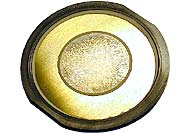The “BUG” or “Piezoo”
The expression “bug” derives from spy world, used for a concealed listening device.
The common or music “bug” is a vibration sensitive device, that is put in contact with the body or bridge of the instrument. It is also called an accelleration transducer, and sophisticated types are used for scientific purposes like hydrophones, power plant bearing monitoring and oil prospecting. The vibration pickup can use one of several working principles.

Large piezo disc from a barcode reader.
The Piezo principle
Most common bugs are the “crystal” or piezo pickup made of a natural crystal (mineral) or a manmade ceramic compound or plastic film material, using the material´s property of displacing a “frozen” electron charge when it is mechanically bent, squeezed or banged with a hammer. This principle can yield very high voltages in a “electronic” cigarette lighter ignition spark. If stuck to the vibrating surface of a musical instrument, the crystal´s flexing is converted into an electric signal. The basic piezo element part costs less than 1 US$.
Some piezo pickups use a single element, others multiple elements. Some are made to be placed on a flat surface, others are fitted into or under the bridge, which is a bad thinking.

The 6 slugs are piezo elements from electronic cigarette lighter ignition.
Pro´s: The bugs are simple to install, some are relatively inexpensive, so you get a cheap amplified sound for few $$. You can also get a cheap sound for free- if you have more time than money and like to tinker, you can easily make one yourself from scrap parts and save over 99% off the price. You can then do any amount of fiddling with it, looking for the holy grail of the right sound. It can be fun, and if you do find the right sound for you, congratulations. Please go to the 1$ DIY pickup page for more details.
Con´s: I have spent too much time trying to make them sound decent. My aims were set too high.
There are good physical reasons for the way the piezoo´s sound:
The accelleration principle is based on detecting the ” rate of speed change”.
Mathematically, this is called a differentiation of speed. For scientific measuring purposes this frequency rise is later integrated (the inverse of differentiation). In musical language this corresponds to treble cut.
Musically speaking, ideal accelleration pickups have a frequency response rising at a steep incline of 20dB per decade. (this means that 5 kiloHerz is ten times louder than 500 herz). Ouch- my ear indeed.
Harmonics of the high notes are then emphasised much more than the low note fundamentals. Especially transients, from plucking and hard bowing are emphasized way out of proportion. The sound of many piezoo´s is further colored by structural resonances in the 2-4 kHz (nasal) range, the most sensitive musical frequency range.
So, it´s no wonder that the piezoo sound has a hard screechy quality, and any amount of “equalising” or interfacing preamp will at best make it sound half right- and all dead.
Billedtekster:
• Large piezo disc from a barcode reader.
• The 6 slugs are piezo elements from electronic cigarette lighter ignition.
